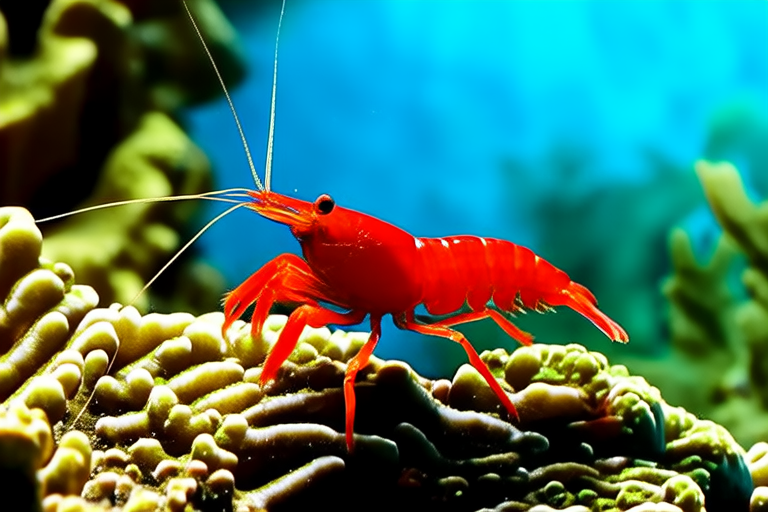How Coral Shrimp Are Transforming Saltwater Aquariums
Coral shrimp, also known as Periclimenes colemani, are small, colorful crustaceans that have become increasingly popular among saltwater aquarium enthusiasts. These shrimp are native to the tropical waters of the Indo-Pacific region, where they inhabit coral reefs and live symbiotically with various species of sea anemones and corals. Their vibrant colors and fascinating behaviors make them a delightful addition to any marine tank. In this article, we will explore the world of coral shrimp, their natural habitat, behaviors, and the benefits they bring to saltwater aquariums.
Natural Habitat and Behavior
Coral shrimp are typically found in shallow waters around coral reefs, where they form symbiotic relationships with various marine organisms. They are often seen living among the tentacles of sea anemones, where they feed on leftover food particles and help keep the anemone clean. This mutualistic relationship benefits both parties: the shrimp receive protection from predators and a constant supply of food, while the anemone benefits from the shrimp’s cleaning activities.
In the wild, coral shrimp are highly active and display a range of interesting behaviors. They are known to be quite territorial, especially when it comes to their chosen host anemone. They will aggressively defend their territory against other shrimp or even larger fish that might try to invade. Additionally, these shrimp are excellent swimmers and can move quickly through the water column, darting between coral branches and other hiding spots.
The Benefits of Keeping Coral Shrimp in Saltwater Aquariums
One of the primary reasons coral shrimp have become so popular in the aquarium trade is their ability to maintain tank health. In a saltwater aquarium, coral shrimp act as natural janitors, consuming algae and detritus that can otherwise accumulate and harm the delicate balance of the ecosystem. Their presence helps to reduce the frequency of manual cleanings and water changes, making maintenance easier for aquarists.
Moreover, coral shrimp contribute significantly to the overall aesthetics of a marine tank. Their bright colors and graceful movements add a dynamic element to the aquarium, enhancing its visual appeal. For example, many aquarists choose to pair coral shrimp with stony corals, creating a visually stunning display. The shrimp are particularly fond of certain types of soft corals, like leather corals, which provide both shelter and a source of food.
Coral shrimp also play a crucial role in promoting the health of corals within the tank. They are known to consume dead coral tissue and algae that could potentially lead to infections or hinder the growth of healthy coral polyps. By removing these harmful elements, coral shrimp help ensure the longevity and vitality of the corals in the aquarium.
Interaction with Other Marine Life
When introduced into a saltwater aquarium, coral shrimp tend to form beneficial relationships with various marine organisms. For instance, they frequently establish symbiotic partnerships with certain species of sea anemones, much like they do in the wild. These partnerships are mutually advantageous, as the shrimp gain protection from predators and a reliable food source, while the anemone receives regular cleaning and maintenance.
Coral shrimp are also known to interact positively with certain species of fish. Some aquarists report that their coral shrimp have formed friendly relationships with smaller, peaceful fish such as cardinalfish and gobies. These fish may benefit from the shrimp’s cleaning habits, while the shrimp enjoy the company and protection provided by the fish.
Common Concerns and Myths
Despite their growing popularity, there are still some misconceptions surrounding the care and keeping of coral shrimp. One common myth is that coral shrimp are aggressive towards other shrimp or small fish. While it is true that coral shrimp can be territorial, they generally do not pose a significant threat to non-aggressive tank mates, especially if ample hiding spaces are provided. Another misconception is that coral shrimp require a specialized diet. While they do benefit from a varied diet that includes frozen foods and algae wafers, they are quite adaptable and can thrive on a standard aquarium diet.
Tips for Setting Up an Optimal Environment
To ensure the best possible environment for your coral shrimp, it is essential to create a well-balanced and stable ecosystem within your saltwater aquarium. Start by maintaining ideal water parameters, including temperature, pH levels, and salinity. Coral shrimp prefer temperatures between 74°F and 82°F (23°C to 28°C) and a pH range of 8.1 to 8.4. Salinity should be kept at approximately 1.023 to 1.026 specific gravity.
Providing ample hiding places is crucial for the wellbeing of coral shrimp. Incorporate live rock, coral structures, and other decorative elements that offer numerous crevices and caves. This not only satisfies their need for security but also mimics their natural habitat, encouraging natural behaviors.
When selecting tank mates for your coral shrimp, it is important to choose species that are compatible and peaceful. Avoid aggressive or predatory fish, as they may pose a threat to the shrimp. Instead, opt for smaller, docile fish like clownfish, damselfish, and blennies. Additionally, consider adding other invertebrates such as hermit crabs or brittle stars, as they can complement the shrimp’s cleaning habits and contribute to the overall health of the tank.
Lastly, it is recommended to feed your coral shrimp a balanced diet consisting of high-quality frozen foods, such as mysis shrimp and brine shrimp, along with occasional algae wafers. Regular feeding ensures they remain healthy and active, further contributing to the overall health of your aquarium.
Conclusion
Coral shrimp are transforming the way aquarists approach saltwater aquariums. With their unique behaviors, beautiful colors, and invaluable contributions to tank health, they have become an indispensable addition to many marine ecosystems. By understanding their natural habitat, behaviors, and needs, aquarists can create a thriving environment that supports not only the shrimp but also the entire aquatic community. Whether you’re a novice or an experienced aquarist, incorporating coral shrimp into your tank is sure to enhance both the beauty and functionality of your marine setup.
